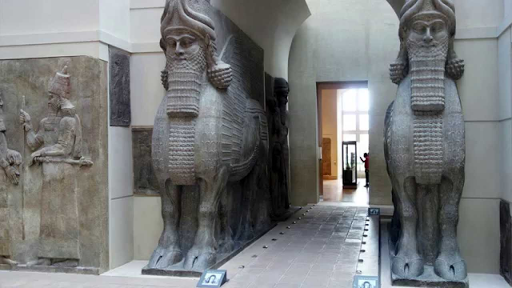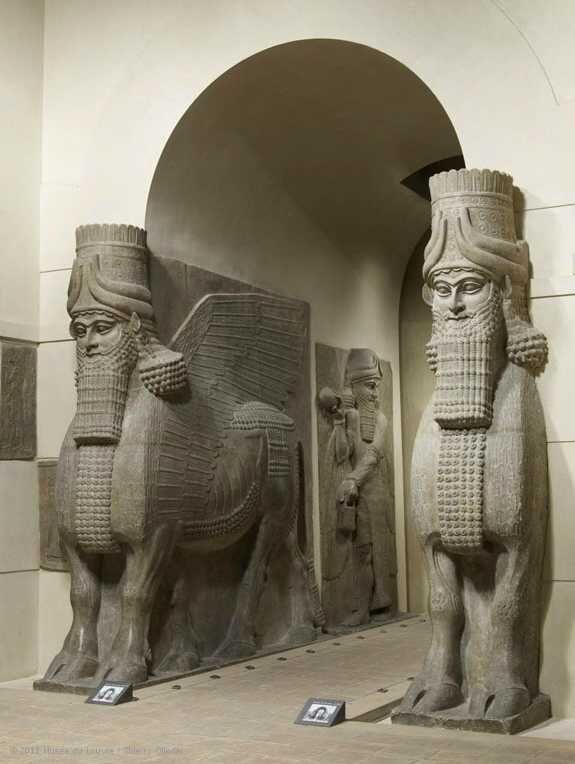The Collection Ancient Near Eastern Art Human-headed winged lion lamassu ca. The Lamassu sculptures were recovered from where.
Human Headed Winged Lion Lamassu Assyrian Neo Assyrian The Metropolitan Museum Of Art
The Assyrian sculpture was discovered in northern Iraq when archaeologists from the OI including Edward Chiera were excavating at Khorsabad Dur-Sharrukin in 1929.

. In the Assyrian mythology there were human headed winged bullslions that were protective genies. The lamassu is a celestial being from ancient Mesopotamian religion bearing a human head bulls body sometimes with the horns and the ears of a bull and wings. The winged beasts from Nimrud in Iraq the ancient city of Kalhu also became quite famous when Lamassu there were ruined in 2015.
What ethnic group is credited with the first system of writing known to man. You can see them at Gate of All Nations at Persepolis in Iran the British Museum in London the Louvre in Paris the National Museum of Iraq in Baghdad the Metropolitan Museum of Art in New York and the University of Chicago Oriental Institute. From what we can tell it seems that these sculptures were believed to protect the palace and king from evil supernatural forces as well.
The most famous colossal statues of Lamassu have been excavated at the sites of the Assyrian capitals created by King Assurnasirpal II reigned 883 859 BC and King Sargon II reigned 721 705 BC. In some cases the lamassu statues were accompanied by. There is no historical evidence showing that Lamassu was worshipped as a god.
Which work has a king approaching the god Shamash. Where were the lamassu sculptures originally displayed. Originally unearthed in Rome and displayed in the Borghese Gallery it was sold to the occupying French and now sits in the Louvre.
First of all the figure has five legs. What color is lapis lazuli. A Sargons palace b Gudeas Lagash c Ashurbanipals palace d Ziggurat at Ur Which of the following played an important role in the shaping of modern art.
However it is displayed in a museum in its original context a lamassu is the guardian of a doorway integral with a wall. The first change was the capital was moved to Dur Sharrukin present day Khorsabad and second the Lamassu was presented on a bulls body compared to a lions and seems to be slightly smiling. There are several fun facts about this sculpture.
Sargons palace gudeas lagash ashurbanipals palace ziggurat at ur. The Lamassu sculptures were recovered from where. Hermaphroditus was actually a popular subject of paintings and statuary even if Written By whitehouse March 11 2022 Add Comment Edit.
Assyrian On view at The Met Fifth Avenue in Gallery 401 From the ninth to the seventh century BC the kings of Assyria ruled over a vast empire centered in northern Iraq. Which work has a king approaching the god. They were represented as double-aspect figures on corners in high relief.
What were the most common themes in Assyrian art. The lamassu and shedu were household protective spirits of the common Assyrian people becoming associated later as royal protectors and were placed as sentinels at entrances. The lamassu are human-headed winged lions or bulls therere many pairs of these sculptures that are still in existence including those in the British MuseumLondon LouvreParis and Metropolitan Museum of ArtNew York as well as several in Iraq.
The Ziggurat at Ur was a fortress funerary monument palace temple platform Where were the Lamassu sculptures originally displayed. Most of todays Assyrians have a sculpture of Lamassu in their You May Also Find These Documents Helpful. Where were the lamassu sculptures originally displayed.
The Assyrians envisioned a protective spirit that was part bull and part human and sometimes part eagle. Lamassu were placed on either side of the doorways of Assyrian palaces and of gateways to cities to protect against evil spirits and impress the neighbors. We were now at the ground level of the original Assyrian palace and the lamassu which were thought of as protective deities stood guard either side of an entrance way.
For this reason it is not an entirely freestanding sculpture. What ethnic group is credited with the first system of writing known to man. Click to see full answer Furthermore where were the lamassu sculptures originally displayed.
This winged-bull known as a lamassu from textual sources was given to the OI by the Department of Antiquities in Iraq. Lamassu the were. Indeed most of the sculptures were placed at gateways palaces underneath the houses and not in the temples.
It appears frequently in Mesopotamian art. The most famous colossal statues of Lamassu have been excavated at the sites of the Assyrian capitals established by King Assurnasirpal II reigned 883 859 BCE and King Sargon II reigned 721 705 BCE. Towering over us each was.
Assyrian sculpture typically placed prominent pairs of lamassu at entrances in palaces facing the street and also internal courtyards. Where were the Lamassu sculptures originally displayed. Backstory The lamassu in museums today including the Louvre shown in our video as well the British Museum The Metropolitan Museum of Art and National Museum of Iraq in Baghdad and others came from various ancient Assyrian sites located in modern-day Iraq.
These sculptures were excavated by P-E.

25 Lamassu From The Citadel Of Sargon Ii Dur Sharrukin Modern Iraq Ap Art History

Lamassu Symbol For Protection Indrosphere

Lamassu Backstory Article Assyrian Khan Academy
Colossal Lamassu Sculpture From The Palace Of Sargon Ii At Khorsabad Sargon Ii Google Arts Culture

Lamassu From The Citadel Of Sargon Ii Video Khan Academy

Lamassus At The Louvre Thatmuse

Lamassu History 2701 Wiki Fandom
Early Excavations In Assyria Essay The Metropolitan Museum Of Art Heilbrunn Timeline Of Art History
0 comments
Post a Comment